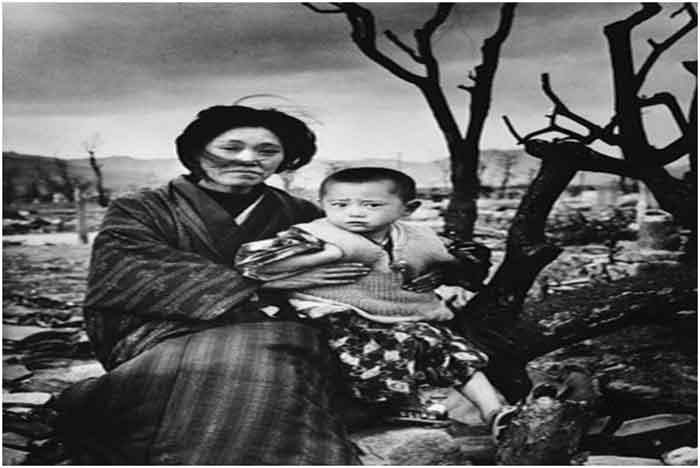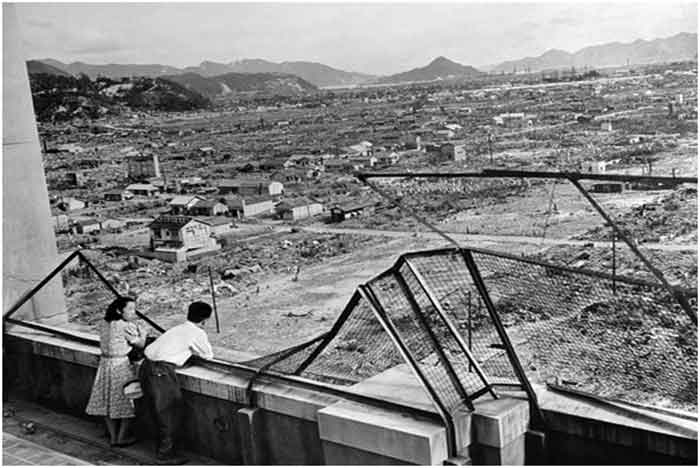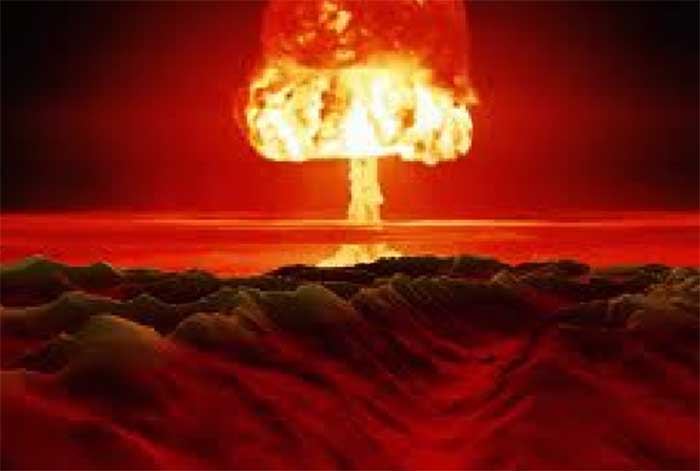
A mother and child, dressed in traditional clothing, sit on the ground amid rubble and burnt trees, Hiroshima, Japan, December 1945; some four months after the United States had dropped an atomic bomb on the city. (Photo by Alfred Eisenstaedt/The LIFE Picture Collection/Getty Images)
On August 6th, in Hiroshima, Japan, people will gather at the Peace Memorial, or A-Bomb Dome to reflect on the 75th anniversary of dropping of the Atomic bomb. Commemorations this year will be scaled back because of the Covid-19 pandemic. This year will be a landmark, and its milestone would have been marked by great international attention. However, for the Japanese people, August 6, 1945 holds a horrific memory to be remembered every year. Those who will gather there will listen to video messages from dignitaries. Together they will say, “Never again!” Once was horrific enough! The Japanese are holding onto this skeleton of a dome as a testimony to the nuclear holocaust during World War II (1939-45). It is important that we as citizens of the world unite with them in remembrance of the first nuclear devastation.
The uranium bomb weighed about 9,700 pounds (4,400 kg) was dropped precisely at 8.15 am and had destroyed 60 percent of the buildings of Hiroshima, the seventh largest city in Japan. 140,000 civilians died that morning. It should be equally significant to us to remember the horror and havoc the bomb had caused to the thousands of unsuspecting Japanese civilians on the morning of August 6, 1945.

The devastated city of Hiroshima following the US nuclear bombing. (Photo by STF/AFP via Getty Images)
Every year, on this day, there is a peace ceremony in Hiroshima, where thousands of doves are released into the sky and prayer bells toll all over the city. Buddhists monks chant hymns – while pounding on their drums. They celebrate the souls of their ancestors, who had died during the bombing. They believe the spirits do visit them on that significant day. Every year, the citizens and spectators from all over the world come to partake in a Peace Lantern Floating ceremony in the evening. The Japanese also believe that the lanterns guide the spirits to heaven. People walk in groups silently, and gather around on both sides of tranquil Ohta River near the Hiroshima Peace Memorial Park.
Thousands of lit lanterns and colorful paper cranes are carried by hand to the river, where they float along the night’s dark water. After the bombing, thousands had fled to these waters to seek refuge and relief from the flames of the Atomic bomb. The water glows from the lights of thousands of paper lanterns, and that I had heard is one spectacular sight for one to see in order to believe. This ceremony is observed to both symbolize peace and encourage the abolishment of nuclear weapons.
Prior to dropping the bomb, U.S. President Harry S. Truman called for unconditional surrender, the last chance for Japan to avoid utter destruction. He said, “If they do not accept our terms they may expect a rain from the air, like which has never been seen before.” Japan refused to the terms of the surrender.
The United States conducted its first nuclear test in July 1945. By dropping the Atomic bomb on the cities of Hiroshima and Nagasaki in August, America officially started the nuclear era. Truman disregarded what kind of implication this bomb meant for humanity. The U.S. scientists who were involved in the Manhattan Project to build the bomb, they all warned Truman. They cautioned him on moral grounds and the setbacks it can cause to civilization. Truman had no patience for moral reasoning, or ethics. His only agenda was to scare Japan into surrender. The scientists and his advisers told him that such devastation would shorten the war, but asked him, is this the right thing to do? “When he (Truman) got Stalin’s confirmation at Potsdam that the Soviets were coming in, he wrote in his diary on July 17, “He’ll be in the Jap War on August 15. Fini Japs when that comes about.” He wrote to his wife the next day, gloating, “We’ll end the war a year sooner now, and think of the kids who won’t be killed!” To save American lives Truman decided to slaughter thousands of innocent Japanese civilians. According to historian Peter Kuznick, “Truman knew that he was beginning a process that could end all life on the planet and said so on at least three occasions.” “While at Potsdam, most famously, he reacted to an in-depth briefing on the incredible power of the Alamogordo bomb test by shuddering, it may be the fire destruction prophesied in the Euphrates Valley Era, after Noah and his fabulous Ark.”
Witnessing the destruction, Robert Lewis, the co-pilot of the U.S. bomber “Enola Gay,” later wrote, “My God what have we done?” That shockwave, encapsulated by those few words, continues to resonate worldwide even after 75 years.
Hiroshima and the subsequent bombing of Nagasaki on August 9, 1945, remain the only time atomic weapons of mass destruction have been used in conflict. It effectively brought World War II to an end.
Those two days (August 6 & 9) changed the world forever. The bomb nearly destroyed the entire city of Hiroshima. After seventy-five years, the destruction is not there for people to see – except the dome. A world tragedy of such magnitude cannot be ignored or pushed out of one’s mind. We need to reminisce, reflect and the world leaders need to come to an understanding that another tragedy of such epic proportions will not happen again.
Reportedly, Truman was not at all troubled that his sinister plan would weigh heavily on the conscience of the future generation of Americans, and the people of this world. Today, in the United States, this monumental task of reasoning through what Truman had done falls on the young people of the country. They become shaken, and perplexed, when they study certain parts of U.S. history. Here in the history classrooms, when they first read about World War II, they may also start thinking about how to make this world a better place, one free of nuclear weapons.
In every school, the students have to debate both the inspiring and less-than-gloried actions that comprise their nation’s history. Often the actions that supposedly made the world free for democracy came at a massive cost. Today’s students most likely stop short of defending someone like Harry Truman without great reflection. Nor do they think it would be “cool” to be in the shoes of Paul W. Tibbets, who piloted the Enola Gay, the B-29 plane that carried the Atomic bomb, named “Little Boy.”
As a junior at the Sidwell Friends School, in Washington DC, my daughter Noor had organized an all-day event called Hiroshima Peace Day. The emphasis of the day was that nuclear disarmament remains an overarching goal for mankind. As a Quaker school, Sidwell emphasizes the search for truth and the pursuit of peace in the daily lives of its students. The students become conscious of serious issues through discussions and workshops. To commemorate and to reflect on the day revisionist historian Kai Bard was one of the guests to speak at the event. Another important speaker was Setsuko Thurlow, who came as an invited guest from Canada to speak. Mrs. Thurlow was a famous survivor of the bombing, known internationally for her activism and story-telling. We were there as well along with other parents to hear a personal account of a survivor of the bombing. With her soft but firm voice, Setsuko Thurlow described the morning of August 6th, 1945. She said at the time she was a girl of age thirteen. That morning she was on the second floor of a wooden building. She remembered seeing flashes from the window and soon lost consciousness from the black smoke. She recounted many stories, and told the audience that it was a sunny summer morning. People were preparing for the day. Children were on the school bus going to school; telephone operators were on their way to work.
Suddenly that morning became the greyest day that anyone had ever seen, or experienced.
A uranium cloud darkened the horizon, and the city of Hiroshima was leveled. The atomic bomb reduced the city to ashes. People in their homes saw flashes of fire in their gardens, and soon realized their houses were engulfed by flames. “Almost all the destruction from radiation, heat rays and blast wave was over within three seconds after the flash of white light. After that, a conflagration continued throughout the day and night, resulting in desolation over a broader area and creating the dramatic, moon-like landscape.” Many people literally melted. Others found their bodies covered with deep cuts, gruesomely disfigured, with blood gushing out. Many were trapped within the fallen rubble. Those who could step outside were blinded by grey smoke and heard people moaning, trying to find their way to hospitals that no longer existed.
One story from Mrs. Thurlow still stands out in my mind. A nine year old girl and her eleven year old sister were getting ready to go to school. All of a sudden, the horizon became a column of rising grey smoke, and the buildings were burning up. Within minutes, the younger girl felt intense fire around her. She later had said in the initial minutes her only thought was if her mother was alright. As a hospital nurse, her mother had already left for work. Days later her sister died, and her charred body was thrown into a ditch, and burnt along with thousands. She never saw her mother again.
She went on living in a house alone and forgotten. Until the day she died, she was haunted by the sound of people moaning in agony, who had died an excruciating death. A lot of the people who survived that blast, later died painfully alone elsewhere in the city. Some survivors were so deformed that for thirty to forty years they remained hidden inside their homes. The disfigured people, along with all the survivors, came to be known as hibakusha.
In May, 2016 the Washington Post columnist Ishaan Tharoor reported on Yasuhiko Taketa and Akihiro Takahashi, two hibakushas. Taketa, a survivor described his experience as: “My forehead felt hot, and I unconsciously touched it with my hand. When I looked at the sky over Hiroshima, I saw a tiny, glittering, white object, about the size of a grain of rice, tinged with yellow, and red, which soon grew into a monstrous fireball. It was travelling in my direction, and I felt as though it was going to envelop me.” At the time of the bombing 14-year-old Akihiro Takahashi who was in line in school told researchers in the late 1980s: “Then I looked at myself and found my clothes had turned into rags due to the heat. I was probably burned at the back of the head, on my back, on both arms and both legs. My skin was peeling and hanging like this.”

September 1945: Hiroshima survivors wearing gas masks, a month after the catastrophe. (Photo by Keystone-France/Gamma-Keystone via Getty Images)
At the end of her junior year in high school, from my daughter’s firsthand accounts from a visit to Japan, I came to know that the city of Hiroshima has been rebuilt – trees have grown back. The city is buzzing with noise; tourists are walking around and taking pictures, exploring the city. Every now and then you can’t help but pause near a window where there is a Peace sign hanging, to reflect for a moment. If you walk a few blocks you might see a banner that reads, May Peace prevail on earth.
From the American side, revisionist historians such as Kai Bird and others have argued the pros and cons of dropping of the bomb on Hiroshima and Nagasaki. The fact remains that every year about six billion dollars are being spent on these weapons by the U.S. alone on research and development of nuclear bombs. In 1961, President Kennedy in his UN address said, “Every man, woman, and child live under a nuclear sword of Damocles, hanging by the slenderest of threads, capable of being cut at any moment by accident, or miscalculation, or by madness.”
The idea of nuclear weapon reduction has been around for some time. “At the time the NPT was concluded, the nuclear stockpiles of both the United States and the Soviet Union/Russia numbered in the tens of thousands. Beginning in the 1970s, U.S. and Soviet/Russian leaders negotiated a series of bilateral arms control agreements and initiatives that limited, and later helped to reduce, the size of their nuclear arsenals. Today, the United States and Russia each deploy roughly 1,400 strategic warheads on several hundred bombers and missiles, and are modernizing their nuclear delivery systems. Each also possesses smaller numbers of non-strategic (a.k.a. tactical) nuclear warheads, which are not subject to any treaty limits.” –Armscontrol.org
Former President Ronald Reagan believed, “The best thing for the world [would be] the abolition of nuclear weapons.” Before his presidency, there were 70,000 nuclear weapons operational in the world. The Federation of American Scientists estimates there are now more than 17,000 nuclear warheads. The estimation is that nearly a quarter of those are classed as ‘operational’. Beyond the shadow of a doubt these weaponries remain a potential source of influence and threat in a world dominated by a small number of nation states. Their destructive power is all too real; their potential for misuse remains great, and a source of unease for the rest of the world.
- March 2019 New START declaration: 1,365 strategic nuclear warheads deployed on 656 intercontinental ballistic missiles, submarine-launched ballistic missiles, and strategic bombers.
- The United States also has an estimated 150 B-61 nuclear gravity bombs that are forward countries: Aviano and Ghedi in Italy; Büchel in Germany; Incirlik in Turkey; Kleine Brogel in Belgium; and Volkel in the Netherlands.
- FAS estimates approximately 3,800 stockpiled warheads and 2,385 retired warheads for a total of 6,185 warheads as of early 2019.
Seventy-five years after the dropping of the atomic bomb, we are still sitting on the verge of a tipping point: a nuclear holocaust can happen again. What former Soviet Prime Minister Nikita Khrushchev said to a group of Western journalists – “We will bury you” – is a phrase we could hear again, from a different, more radical leader’s mouth in these uncertain times. After many years of disarmament efforts, there are still thousands of nuclear weapons aimed at the U.S., Russia, China, North Korea, Iran, India, Pakistan and many other nations. The world still teeters on the edge of disaster, with the threat of nuclear terrorism all too real.
History has shown, even one nuclear bomb is too many. We do not ever want to walk through a post-apocalyptic burned city like some science fiction characters.
The Atomic bomb brought to the world a “new kind of horror, one that had therefore been unknown in the human experience.” The horror encapsulated by the dropping of the atomic bomb on August 6, 1945 still remains a possibility. With nine countries having nuclear weapons, the question remains if it happens again, whether humanity could survive it. One of these nations might be tempted to use it once more on another country under same circumstances. The probability is reminding me of Cormac McCarthy’s novel The Road. The story is about a father and son’s journey walking through post-apocalyptic America hoping to find a place of refuge. All the plants and animals are dead, and only a few human survivors are eating each other alive. But, I want to close this column on a positive note: Many around the world are in awe seeing how the bitter memories of the nuclear war did not destroy the spirit of the Japanese people. Japan has recovered from the devastation to become a formidable global power and a friend of America’s. From the ashes of that dreadful nuclear holocaust, they rose like a phoenix with renewed energy.
Postscript: An abridged version of this article was originally published on August 6, 2014 in the bdnews24.com, an online news portal in Dhaka, Bangladesh. Six years on, I have made some necessary modifications by rewriting a few paragraphs, updating some information, and added some pictures depicting the aftermath of the devastation.
Zeenat Khan is based in Maryland, USA
SIGN UP FOR COUNTERCURRENTS DAILY NEWSLETTER














































